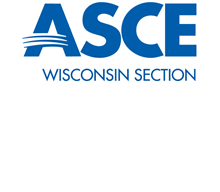Wisconsin civil engineers give Wisconsin a “C” on its 2020 Infrastructure Report Card, an average across 13 categories ranging from a “B” for energy to a “D+” for roads and transit.
The report card was released today by the American Society of Civil Engineers Wisconsin Section. The most pressing need, according to ASCE Wisconsin Section members: Wisconsin roads and highways.
“We can’t move goods across the state, and that’s not even just with roads, but I would also add in there the ports as well as the inland waterways, any which way we can move produce and other materials… in and out of state is key for our economic success,” said ASCE Wisconsin Section President Ken Mika.
According to Mika, roadway features in Wisconsin are likely a determining factor in about one-third of fatal traffic crashes. In addition, the value of lost time and wasted fuel due to driving congestions in Wisconsin is approximately $1.9 billion a year.
“Vehicle miles traveled in Wisconsin are pressing in an upward trend with an increase of over 13 percent since 2009, while the population grew only 8 percent,” he said. “Congestion is experienced on 635 miles of state highway and this is expected to increase to 776 miles by 2023 under current trends.”
The congestion is expected to have an adverse impact on $510 billion worth of commodities that are shipped annually using Wisconsin highways, Mika added.
ASCE Wisconsin Section said that the infrastructure grades were not at all a reflection of the government agencies.
“I think that the ASCE report card… confirms what this administration has been putting out and the governor has been trying to point out is that decades of disinvestment of our roads has left them in poorer condition than they should be, which is why we’ve made it such a priority to set about improving them,” said Department of Transportation Secretary Craig Thompson in an interview.
Gov. Tony Evers’ budget was the first in over a decade that had additional revenue for transportation at $465 million, Thompson said. All of that money was to go into fixing roads that Wisconsin currently has. About $320 million went into the state highway rehabilitation program, and the rest went into local road improvement programs for roads and bridges.
He added that while the 10 percent increase compared to budgets past may not be enough to improve the conditions, it’s enough to stop the decline of roadway conditions.
“That was a significant step forward. It didn’t get us where we need to be, but it was a significant step forward,” Thompson said.
The report grades aviation, bridges, dams, drinking water, energy, hazardous waste, inland waterways, ports, roads, solid waste, stormwater, transit and wastewater. The scores aim to help citizens and decision-makers understand how the state’s infrastructure is faring and what can be done to modernize its systems.
The majority of the state’s infrastructure is doing an adequate job of meeting the needs of Wisconsinites, including energy, which scored the highest marks.
Mika praised elected officials in the Public Service Commission that are helping the stakeholders and utilities meet the energy needs of Wisconsities and growing the next power generation of wind and solar. This supports Evers’ goal to reach net-zero greenhouse gas emissions by 2050.
However, he noted that without expanded use of innovation, funding and asset management, positive infrastructure trends will not continue.
“If Wisconsin can capitalize on the innovation with good communication across all sectors, they could be on the forefront in maintaining what they have and updating systems,” Mika said.
The ASCE suggests four steps to raise Wisconsin’s infrastructure grade: increase investment; set project priorities; target discussion between state and federal leadership about necessary updates, including reauthorizing the Federal Surface Transportation Program; and increase efficient new technologies, design and construction.
Martin Hanson, treasurer of ASCE Wisconsin Section, was unable to put a price tag on an “A+” for Wisconsin.
“Achieving an A+ grade, although an admirable goal, in most circumstances, may not always be the best management decision,” he told WisBusiness.com. “The incremental costs in (one) sector to go from a B to an A may be better spent on increasing another sector from a C to a B. Federal, state, and local managers must prioritize their projects to best meet the needs of their sectors.”
Today’s report card was the first since 2007. The ASCE refuses to compare this report card to the one from 2007 or scores from other states noting that the criteria has changed in the last 13 years and differs from state to state. The society said it will continue to update the report card every four years and compare those scores.
Watch the announcement:
https://www.facebook.com/254157507936295/videos/378570763144738
See the release:
https://www.asce.org/templates/press-release-detail.aspx?id=38819
-By Stephanie Hoff
WisBusiness.com






